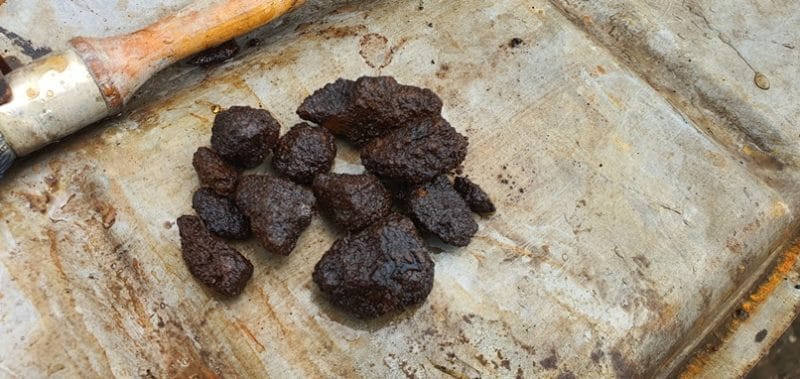Friend Thijs is not only an amiable person and a passionate entrepreneur. He is also a thoroughbred technician who is afraid of few things and who thinks very solution-oriented. Yet even at home he comes across things that surprise him. This is how he discovered why his perfect Simca Aronde suffered from fuel poverty. Over the years, his gas tank had developed kidney stones.
Gasoline is thin stuff. It sloshes. But what did Thijs find in the tank? Rock hard petrol pebbles. Gum and varnish are known precipitation products. They usually precipitate in layers. But in this case a kind of ring dike had been created around the fuel suction pipe.
We are here with people who are fairly handy mechanically. But chemically we are a kind of third world inhabitants.
Does anyone have any idea what happened in Thijs' tank? Comments are welcome!




Never experienced anything like this in the XNUMXs. A customer with a fairly new Japanese car complained about drag on the highway. In normal driving with lower power demand there were no problems. After a long search, we first thought of the then mechanical petrol pump, after removing the tank float, we came across a completely transparent sheet of newspaper in the tank. Yes, a Japanese newspaper! the paper had become transparent and the photos were still visible. The newspaper sucked itself against the tank strainer…..production error….
My C310 had also stood still for a long time and a kind of amber had formed at the bottom of the tank ... crackling hard, had to be easily chipped out
Looks like these 'drops'..
Amber… What a positive approach!
What I learned from a Belgian with old motor tanks:
Fill with aquarium stones, and then hang it in the concrete mixer or go to a paint farmer with mixing device.
Mess and rust out.
BP Ultomate in it.
Clean fuel cock + filter.
Check cap for working vent.
E10 fuel hose..
Carburetor Ultrasonics.
If you drive regularly after this, you will have NO problems for the first 5 years.
TIP : NEVER refuel ARGOS – DE HAAN' or BERKELMANS.
He15 process ie 15% wet bioethanol.
Give it a try.
Success assured.
Good tip maybe?
gr.Frank ( race techie ).
Thank you for that!
Reaction to the thickened petrol from the tank of the Simca Aronde of Thijs. Could it be that the Simca has been fairly warm, where the volatile part of the gasoline has evaporated through the vent and other seams? Just store petrol in a plastic jerry can. It can also inflate quite a bit. Only the more solids remain in the tank. Think of the reverse of refining. It reminds me of the moped days when all kinds of junk was found in the carburettor. Old petrol and oil should always be replaced.
But yeah. It's just like that gorgeous girl you meet with classics. You don't know what she did for you
It is possible that the tank was once provided with a coating on the inside.
This coating is also known to dissolve with modern petrol, just like the polyester petrol tanks from the late 80's and 90's.
Could be. But the matter remains unclear. It really had to be eaten
Some organic substances will polymerize on their own under the influence of contact with iron. This resembles something that I have seen more often with Benzyl chloride in our chemical plant. Is not gasoline, but the (rotten) stuff made from xylene has the property to polymerize when it meets iron. Perhaps something similar went wrong in the tank of the Simca Aronde. It could also be that a whole load of old petrol has just been gummed up. Filling with new stuff does not dissolve the gum. It may curl loose, but nothing more. Then when it's sloshed and banged by the tank, it just rolls up the rust particles it encounters as if you were rolling a ball of putty over it.
At my old Honda C310 I once worked for days to get that old stuff out of a bad 1 Gallon tank.
All good works take time!